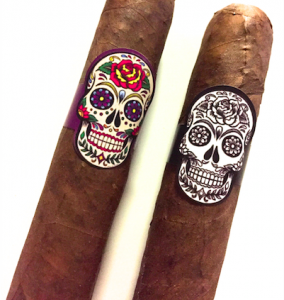Cigars in films play a role of their own; they are not solely used as a prop for the actors to hold but they are meant to be used for the addition of style and attitude to the actor, in not only Classic Hollywood films but also International films. Some of the many performances given by major actors in Hollywood, are known for the amount their characters have smoked on screen and possibly even off screen.
Humphrey Bogart - The Maltese Falcon, Casablanca, and The Big Sleep
Bogart?s characters and his performances were basically incomplete without a cigar between his fingers. The presence of the cigar in the same frame as Bogart symbolizes masculinity and toughened persona. His dialogue delivery happens to emit a feeling of intimidation in the actors performing opposite him and the audience as well; it also establishes his superiority - which of course, is also because of the cigarette in his mouth and the smoke he blows in the frame.
Clint Eastwood - The Good, The Bad, The Ugly, and A Fistful of Dollars (Spaghetti Westerns in general)
Spaghetti Westerns would not be their own genre if it were not for the iconography existent in the films such as cowboy hats, horses, guns, and the cigars in every cowboy?s mouth and pocket. Clint Eastwood is one of the main pioneers behind making Western films a genre by itself and also bringing the global audience to the Western genre. Although, Humphrey Bogart acted in film noir dramas more than westerns, the purpose of the existence of the cigars is pretty much the same in Clint Eastwood?s films as well.
James Dean - Rebel Without a Cause
Rebel Without a Cause was automatically one of the major films that had an impact on the youth of America. As a youngster, it is but natural to feel that a distinct attitude needs to be projected around peers and a quality of ?coolness? needs to be displayed at all times, to ?fit in? and also to gain a popular status in the community. Cigarettes have helped illustrate the image of the ?hip and happening? teenager since Rebel Without a Cause. James Dean?s character in particular is the perfect example of how a teenage guy?s personality naturally emits a boyish kind of charm. However, the cigarette in Dean?s mouth exerts a ?man-like? quality and image.
Al Pacino - Scarface and The Godfather
Gangsters. Drugs. Guns. It sounds like we?re missing a tiny vital detail, aren?t we? No, we are not. Cigars are an essential part of this film since it is a story about gangsters. Once again, it is quite difficult to exclude cigars from the characterization of gangsters. Making an offer to someone who should not refuse it? Light your cigar and the other?s as well because that was an obvious norm amongst men. In an intense scene in The Godfather, Enzo, the baker, is put on the spot to act like an armed man guarding the hospital entrance for Don Corleone, along with Michael Corleone. The first thing Enzo does when the strangers (possible hired assassins) drive away, is light a cigarette to shake off the nerve wracking anxiety. Additionally, in an action sequence, the violent action will continue in the scene but the characters do not stop smoking the cigarettes in their mouths. A gangster?s hands are made for holding a cigar in one and a gun in the other.
Goodfellas
Goodfellas was set in New York 1970s, and cigars in this film serve the same purpose as they do in Scarface and The Godfather. Since gangsters are essentially businessmen, cigars over cigarettes for them serve as a symbol of high status and power. Not to mention the fact that the illegal business that the gangsters were managing and distributing in the beginning of the film were cigars. To be honest, what else do gangsters live off of? Cigarettes in a film can represent any mood - celebration, anxiety, defensiveness, seduction, intimidation, or basically any kind of attitude a character needs to emit. If characters do not tend to smoke in films, then that is due to their nature of being ?the innocent, good, and neat one? or the one who does not waste time in indulging in ?such useless matters.? All of these perceptions of those who smoke cigars and those who do not on screen have a substantial impact on the audience. As an audience, we might have associated these qualities with the female character and automatically assume that she does not smoke. However, there are memorable female characters from Hollywood who have impressively used cigars as a prop throughout some of their films.
 Anne Bancroft - The Graduate
Anne Bancroft - The Graduate
Need anyone say more about Anne Bancroft?s character and the purpose of her cigarette? It?s sole use in The Graduate is seduction. When a woman casually blows smoke into a man?s face, it?s either to seduce him or shoo him off.
Molly Ringwald - The Breakfast Club
The character that Molly Ringwald plays in The Breakfast Club, Allison, is basically the female version of James Dean from Rebel Without a Cause (not necessarily in the sense of characterization but considering the commonalities between them in regards to age and attitude, Molly Ringwald produces the same qualities and characteristics with the cigarette in her mouth).
Audrey Hepburn - Breakfast at Tiffany?s
Audrey Hepburn plays the main character, Holly Golightly, who if we met, we would assume she is very materialistic and a happy-go-lucky lady. However, she is a woman with an emotionally traumatic and painful past. There is a figurative wall that surrounds Holly Golightly which many of the other characters in this film find challenging to break down. As an audience, we may interpret her usage of the cigarette is form of style and a defense mechanism. The most iconic image of Audrey Hepburn?s in this film is her using a three-foot cigarette holder. However, the significant ways in which Audrey Hepburn uses it - pointing it in different directions and casually carrying it over her shoulder, are more unique and smart than the way any actor has used a prop.

 Anne Bancroft - The Graduate
Need anyone say more about Anne Bancroft?s character and the purpose of her cigarette? It?s sole use in The Graduate is seduction. When a woman casually blows smoke into a man?s face, it?s either to seduce him or shoo him off.
Molly Ringwald - The Breakfast Club
The character that Molly Ringwald plays in The Breakfast Club, Allison, is basically the female version of James Dean from Rebel Without a Cause (not necessarily in the sense of characterization but considering the commonalities between them in regards to age and attitude, Molly Ringwald produces the same qualities and characteristics with the cigarette in her mouth).
Audrey Hepburn - Breakfast at Tiffany?s
Audrey Hepburn plays the main character, Holly Golightly, who if we met, we would assume she is very materialistic and a happy-go-lucky lady. However, she is a woman with an emotionally traumatic and painful past. There is a figurative wall that surrounds Holly Golightly which many of the other characters in this film find challenging to break down. As an audience, we may interpret her usage of the cigarette is form of style and a defense mechanism. The most iconic image of Audrey Hepburn?s in this film is her using a three-foot cigarette holder. However, the significant ways in which Audrey Hepburn uses it - pointing it in different directions and casually carrying it over her shoulder, are more unique and smart than the way any actor has used a prop.
Anne Bancroft - The Graduate
Need anyone say more about Anne Bancroft?s character and the purpose of her cigarette? It?s sole use in The Graduate is seduction. When a woman casually blows smoke into a man?s face, it?s either to seduce him or shoo him off.
Molly Ringwald - The Breakfast Club
The character that Molly Ringwald plays in The Breakfast Club, Allison, is basically the female version of James Dean from Rebel Without a Cause (not necessarily in the sense of characterization but considering the commonalities between them in regards to age and attitude, Molly Ringwald produces the same qualities and characteristics with the cigarette in her mouth).
Audrey Hepburn - Breakfast at Tiffany?s
Audrey Hepburn plays the main character, Holly Golightly, who if we met, we would assume she is very materialistic and a happy-go-lucky lady. However, she is a woman with an emotionally traumatic and painful past. There is a figurative wall that surrounds Holly Golightly which many of the other characters in this film find challenging to break down. As an audience, we may interpret her usage of the cigarette is form of style and a defense mechanism. The most iconic image of Audrey Hepburn?s in this film is her using a three-foot cigarette holder. However, the significant ways in which Audrey Hepburn uses it - pointing it in different directions and casually carrying it over her shoulder, are more unique and smart than the way any actor has used a prop.